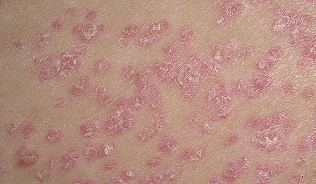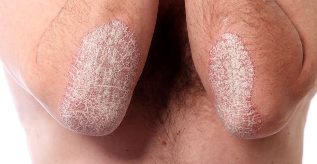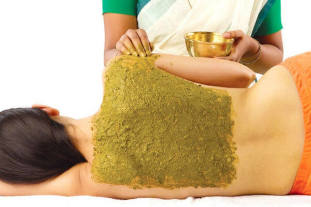By interfering with the psoriasis, many patients do not immediately recognize the pathology, taking for allergic skin rashes and some other dermatitis. For a rapid diagnosis of the disease it is important to know how is the pathology, what are the different stages of psoriasis and manifestation of the disease at different stages. The progression of psoriasis is characterized by four stages, among which emit primary progressive, fixed-stage and stage of regression. In more detail each of the steps is considered in the article.
The initial stage of psoriasis

Many patients are interested in what looks like psoriasis of the initial phase? See the first manifestations of the disease may be on the photo. For this phase, the tendency to a development of the skin typical red, pink spots with clear boundaries. The disease can occur on different parts of the body. Then provided the picture of the pathology on the different areas of the body.
The symptoms of psoriasis on the initial phase
For the initial phase of the disease is characterized by the following symptoms:
- a slight desquamation of the dermis;
- redness of the skin;
- the development of the itching;
- the feeling of dryness, tightness;
- the formation of spots of different diameters;
- the gradual strengthening of the flaking.
The clinical picture of the pathology may vary depending on the type of disease. Thus, in the case of guttate psoriasis of the size of the plates has a little diameter, no more than 2 — 3 mm When the shape the most common shape, vulgar, rash, reach a considerable size, larger than 5 cm, often fused between them, constituting the great lakes. For pustular psoriasis is specific to the education on the dermis of the crust with a yellow or grayish hue to the accumulation of serous liquid in them.
The first step of the duration of each patient is different. It depends on the type, the immunity of the patient, and other characteristics of the organism.
The treatment of the initial phase
For the early stages of the disease is most often prescribed a topical treatment of lesions with the help of ointments, gels, lotions. The medical treatment aims to eliminate the itching, flaking, swelling, redness, inflammation. To do this, use of hormonal and non-hormonal ointment.
The hormone treatments of the initial phase prescribe rarely. Often, their use indicates patients with current acute pathology.
Hormonal ointments often cause side effects. The use, it is recommended only by a doctor.
Progressive stage of psoriasis

Progressive stage characterized by a manifestation of the disease, platelets is more, the itching, flaking, swelling, inflammation intensifies. Eruptions on the skin begin to melt between them, striking substantial portions of the dermis. On the stage, often appear this kind of symptom, as a phenomenon kebnera. The essence of the phenomenon lies in the fact that new skin rashes appear in places with skin lesions. If the skin there are scratches, abrasions, burns, in their place, with a high probability, there are plates. The duration of the phase of progress lasts for an average of 14 days to several months. In each patient, this time interval depends on the individual characteristics of the organism and the rapidity of immunity to pathology.
Treatment stages
While acute psoriasis requires a holistic approach using the following methods:
- The medication treatment.
- The use of physiotherapy.
- The correction of the image of the patient's life.
It is important! The tactic of treatment is adjusted individually for each patient, depending on the severity of the disease, the characteristics of the flow and the presence of complications.
Drugs
To get rid of the plaque and reduce the symptoms of the disease in the medical practice use the groups of drugs:
- Antihistamines – designed to reduce these manifestations, such as itching, redness.
- The drugs sedative – allow you to remove the stress, to normalize sleep.
- Anti-inflammatory drugs – reliable remove an inflammatory process, helping to eliminate redness and other signs of disease.
- Diuretics are medicines, calculated after the removal of the body of excess fluid and salt. These drugs help to clean the body, which has a positive effect on the course of the disease.
- Keratolytic – contribute to a good exfoliation of the epidermis, to manage the regeneration of the dermis, its update.
- Immunomodulators – regulate the work of the immunity of man, which is an important condition for the healing.
- Hormonal ointments – give quick results, are used mainly in severe disease.
- Cytostatic – have the property of inhibiting the immune system, it is sometimes necessary to get rid of psoriatic plaques.
All medications must be used exclusively after the appointment of a physician. The medication will only worsen during the pathology.
Physiotherapy
The methods of physiotherapy are the following:
- PUVA-therapy;
- Use of ultrasound irradiation.
- The magnetic therapy.
- Selective therapy.
- The laser beams.
- The mud therapy.
- Paraffin bath.
- The spa treatment.
The number of sessions and their duration chooses a doctor, given the characteristics and the type of the disease, as well as the personal qualities and the well-being of the patient.
The traditional methods

Folk therapeutic methods are recommended:
- Natural oils (genivre or lavender). Have healing and soothing effect, a beneficial effect on the condition of the skin. Method of use: a few drops of oil, add in the cream and dotted line, apply it on the rash.
- Hydrogen peroxide (3%). Applied in dotted lines and is not washed. Before the application, it is necessary to consult a dermatologist.
- 30 g of propolis, mix it with 250 ml of vegetable oil (oil first boil). The mixture obtained should be applied for the dissolution of Horny epidermis, and the restoration of the elasticity of the skin.
- The bee wax. This product has anti-inflammatory properties and a soothing effect. The wax needs to melt in the bath water, and apply on the skin covering the papules.
- Honey. The main product of the vital activity of the bees has a positive effect on the human body in psoriasis. It must be consumed in limited quantities – 2 tablespoons per day.
Dye psoriasis
Of the popular methods of treatment are used all the same oil and hydrogen peroxide.
You can add the dye to the basis of celandine. For its preparation, need 3 tablespoons of this plant (dry or fresh) and salt water. In any case, do not use alcohol, because this can dry the skin.
How to cook a therapeutic tool:
- the components should mix with each other;
- leave a couple of hours.
Before you apply the stain to the skin, it is recommended to anoint birch tar (in dotted line), to strengthen the curative effect.
For that treatment has been effective, the patient should go on the diet, harmful products cause a worsening of the condition.
The diet of psoriasis

Patients with psoriasis, it is essential to adopt a good diet. Compliance with the diet will help quickly clean the skin plates, to avoid the complication of the disease.
The principles of therapeutic nutrition:
- It is necessary to abandon spicy, salty, acidic, and fried foods. These products only improve the growth plates.
- The diet should be filled with a lot of vegetables, fruits.
- The main role is best to choose dishes of cereals, soups, lean meat and fish.
- On the table should be of allergenic products. You need to give up eggs, nuts, chocolate, citrus fruits.
- Beverages containing caffeine are also excluded.
- No alcohol, carbonated beverages.
- Dairy products should not contain fat. Preference should be given yogurt without additives, yogurt, milk.
Take food, it is recommended that small portions, avoiding eating too much. The diet is a component of the therapy of the disease. A good diet helps to saturate the body with vitamins, get rid of toxins.
The stationary phase
Fixed the stage is characterized by a decline in the growth of psoriatic plaques, at their number on the body does not diminish the disease as a goes to standby mode. In the presence of trigger factors from the pathology fixed can move on to a new phase of progress. The reasons of this phenomenon is of ill treatment, refusal to follow a diet, a trauma of the skin. The duration of the stationary phase is so different for different patients, which is quite difficult to imagine its limits. On average, it is time to take a few weeks to several years.
The regression phase
The regression phase is the last step before the remission of the disease. Here are indicated the following changes:
- The color of the papules of bright red passes in the clear, the rose tint.
- Decreases the number of peeling.
- Lot of itching.
- The skin is cleansed, acquires smooth color and structure.
- On certain areas of your body to keep so-called "guardians of the plate". The rash is not completely pass, remain on the skin, even in period of remission.
Psoriasis refers to a chronic dermatitis, non-infectious nature. Completely get rid of the condition is impossible today. Patients having a pathology, need for a lifetime of stick prevention focused on the prevention of recidivism. Many patients can not save the period of remission for the years to come, to lead a full life.
























